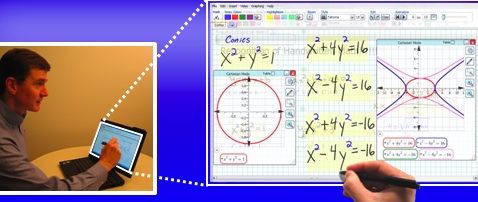FluidMath: Game-like Digital Calculations

I recently had a conversation with a way too smart, young mathematician/entrepreneur, Don Carney, Ph.D., who gave me a one on one demonstration of something called FluidMath put out by Fluidity. I’d bravely taught 5th grade math, and even some at the 7th and 8th grade levels, so didn’t think what was left of my hair would hurt during his presentation. I told Carney that I wanted to be moved by his software, and wanted to see it spin, dance and turn. I didn’t know that I had left out “Wow”, until Don asked me if I had gotten all I’d asked for from his presentation. Yep, FluidMath had me saying “Wow” and repeating it.
FluidMath is pencentric, or centered on using a digital pen, but I believe that it is touchcentric as well. In other words, teachers and students take digital pen in hand to do and solve math problems. The FluidMath software recognizes your handwriting, and does a great job at it. Carney’s handwriting, I have to admit wasn’t something to hang from the refrigerator door, but the software was able to recognize his chicken scratching without any software training. It just worked. Best of all, it avoided all the nonsense you might get with doing math using keystrokes. If you’ve tried doing equations using a keyboard, you know what I’m talking about. It’s another set of skills that most of us have difficulty mastering, and for the most part it’s a lot slower than the pen when it comes to math. For this, the pen is mightier… and faster than the keyboard.
I do know that teaching math, testing hypotheses, and creating graphs based on data take time, but are essential teaching and learning skills. What I saw FluidMath do in moments, well, would have taken a great teacher a class period or more—most likely 3 classes to do. While the good math teacher could have done this, there is no doubt in my mind that FluidMath did it better and quicker. I believe it can help make an OK math teacher great, and a great math teacher a super star. Students actually can manipulate their math equations in real time to see if what they estimated, or worked makes math sense—or is correct.
If you teach Algebra or Calculus FluidMath is a necessity. And the possibilities for physics and other sciences are astounding, too. Speed and distance calculations and trials make working science game-like with this software.
I saw the FluidMath software demo on a Fujitsu tablet, and it worked beautifully… flowingly. Fujitsu has been doing pen computing for years, so they’ve pretty much mastered it. This sort of software is a good marriage, there, but it also works on other touch devices/platforms as well. Love to see it on a whiteboard; I’m sure it would “Wow” a larger education audience that way.
It’s probably not the best way to see FluidMath in action, but I was quite impressed with the online demo at the Fluidity Site. It may load a bit slowly on older laptops, like mine, but it is well worth the wait. Watching the video there will help you understand why I’m so enthusiastic about its teaching possibilities. I think these young Ph.D.s have something here that can make math and science really cool, and require very little teaching professional development. If you know your subject, and can write with a pen—it works. The software framework for FluidMath is only the tip of its possibilities for education.
Ken Royal is a teacher/education and education technology blogger/reporter, video interviewer, podcaster, education event news commentator with 34 years of classroom/school and instructional technology experience. His teaching accomplishments include: 4-time district teacher of the year, Connecticut Middle School Teacher of the Year, and Bill and Melinda Gates award for Technology School of Excellence. Read more of Ken’s work at Royal Reports.
Tools and ideas to transform education. Sign up below.
